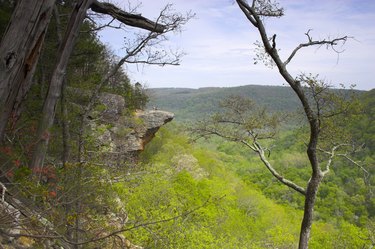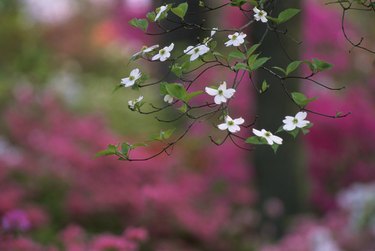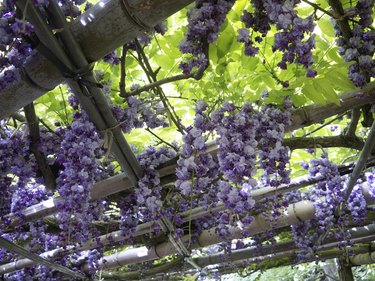
Located just above Louisiana with its eastern edge bounded by the Mississippi River, Arkansas spans U.S. Department of Agriculture plant hardiness zones 6b through 8a. The state has two natural main divisions, the northwestern highlands and the southeastern lowlands. The mountainous highlands contain hardwood forests. The lowland terrain, some of which is also forested, is flat to rolling. A wide variety of Arkansas' native plants are suitable garden subjects.
Small Trees
Video of the Day

In spring, Arkansas' woodlands are alight with showy pink and white flowers produced on two smaller-sized, usually multitrunked trees. Recreate this display in your garden by planting pink-flowered eastern redbud (Cercis canadensis), hardy in USDA zones 4b through 9a, and flowering dogwood (Cornus florida), hardy in USDA zones 5 through 9a, with white flowers. These deciduous trees fall into the range of 20 to 35 feet tall. Both bloom before leaves emerge in the spring. Redbud's glossy, heart-shaped leaves turn yellow in fall. Dogwood provides red to red-purple fall leaf color and clusters of bright red fruits. There are a number of dogwood cultivars with white to pink flowers.
Video of the Day
Vines

Useful for softening fences, walls, trellises and arbors, deciduous vines provide summer shade and winter sun. American wisteria (Wisteria frutescens), growing in USDA zones 5 through 9, inhabits native streamsides and thickets. Provide full sun for better production of the pendant clusters of showy, fragrant, purple flowers. American wisteria reaches 15 to 30 feet tall but doesn't have aggressive growth. For a vine with fall interest, virgin's bower (Clematis virginiana) reaches 12 to 20 feet tall and 3 to 6 feet wide in USDA zones 3 through 8. Starry-looking, fragrant white fall flowers are followed by showy, plume-like seed clusters that form on female flowers.
Sunflower Family Plants

Many sunflower family plants have flower heads that contain numerous individual small flowers. Showy ray petals surround a central disc that has many, small, tubular flowers. A perennial wildflower with purple ray petals and a conspicuous, cone-shaped disc, purple coneflower (Echinacea purpurea) grows in full sun and blooms all summer and fall, attracting butterflies and bees. Drought tolerant once established, the plant grows 3 to 6 feet tall and 1 to 3 feet wide in USDA zones 3 through 8. With smaller flowers, spreading aster (Symphotrichum patens) inhabits open woods and thickets, growing in sun or partial shade. Hardy to USDA zones 4 through 8, the 3-foot-high branching plant's abundant blue- to violet-rayed flowers occur in late summer and fall. Plant spreading aster in well-drained, average soil.
Woodland Wildflowers

The bright red spire of brilliant red flowers on the cardinal flower (Lobelia cardinalis) draws the eye as well as the hummingbirds. Inhabiting moist soils along streams and in low woodlands, cardinal flower needs rich, moist-to-wet soils. Locate plants in full sun in cool areas and partial shade in warmer areas. Hardy in USDA zones 3 through 9, cardinal flower grows 4 feet tall by 2 feet wide. For a lower-growing plant 1 to 2 feet tall and wide, eastern beebalm (Monarda bradburiana) has showy, pink-to-white, spotted flowers arranged in a whorl around the stem. The tubular flowers offer nectar to butterflies and hummingbirds throughout the summer. Eastern beebalm is native to dry, open woodlands and glades. It prefers well-drained soils and either sun or part shade. Aromatic leaves are fragrant when handled.
- U.S. Department of Agriculture Agricultural Research Service: USDA Plant Hardiness Zone Map
- Arkansas Natural Heritage Commission: The Natural Divisions of Arkansas
- Arkansas Natural Heritage Commission: Native Plants for Your Arkansas Garden
- University of Florida IFAS Extension: Cercis Canadensis Eastern Redbud
- University of Florida IFAS Extension: Cornus Florida Flowering Dogwood
- Missouri Botanical Garden: Wisteria Frutescens
- Missouri Botanical Garden: Clematis Virginiana
- Fine Gardening: Purple Coneflower (Echinacea Purpurea)
- Missouri Botanical Garden: Symphotrichum Patens
- Missouri Botanical Garden: Lobelia Cardinalis
- Missouri Botanical Garden: Monarda Bradburiana